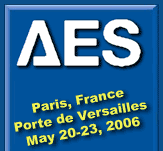

Home | Technical Program | Exhibition | Visitors | Students | Press
Last Updated: 20060405, mei
Monday, May 22, 13:30 — 15:30T15 - METADATA MANAGEMENT
Presenter:
Michael Zimmerman, VCS - Germany
Abstract:
Summary
1. What is metadata?
Metadata (Greek: meta- + Latin: data "information"), literally "data about data", are information about another set of data.
A common example is a library catalogue card, which contains data about the contents and location of a book: They are data about the data in the book referred to by the card. Other common contents of metadata include the source or author of the described dataset, how it should be accessed, and its limitations. Another important type of data about data is the link or relationship between data. Some metadata schemes attempt to embrace this concept, such as the Dublin Core element link. …
2. Types of metadata
Types of metadata addresses the different use cases where metadata is required. These can be databases, programs, files or other scopes for metadata.
3. Metadata standards
Depending on the use case there several standards that can be used to achieve a common description and schema of metadata. There are open standards like Dublin Core that are not related to a certain set of data and can be applied to nearly every data. There are as well specialised sets of metadata e.g. from the EBU, BBC or IRT that address a subset of data or a certain use case. This chapter should give an overview of the existing standards and their purpose.
4. Usage and structure of metadata
a. External description of data, e.g. XML or XML Schema.
b. Internal description of data, e.g. MXF, BWF, TIFF
c. Linking and building relationships between sets of data, e.g. RDF and OWL
d. Adding semantics and meaning to metadata, Semantic Web, ontologies and topic maps
5. Conclusion
The recent possibilities for digital metadata management offer great possibilities accompanied by great risks. The conclusion should state the problems and chances arising from the recent situation.